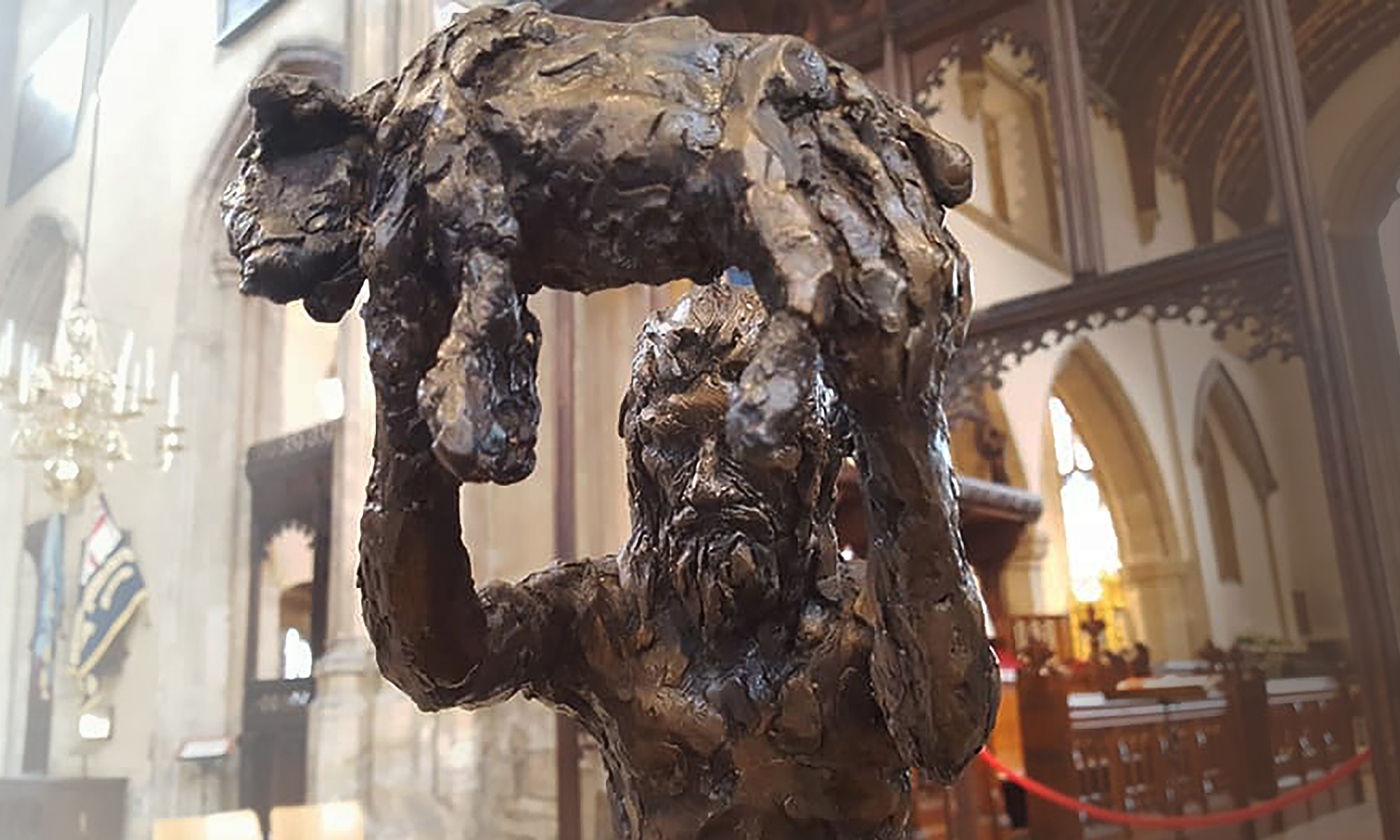Statement of Need for Project Black Jack: restoration of two statues to the tower of St John Baptist Parish Church, Cirencester.
General Information
As set out in the Statement of Need, St John Baptist is one of the largest parish churches in England and has been a place of Christian worship for well over a thousand years. It is a Grade 1 listed building and is one of the most significant Anglican churches in Gloucestershire, second only to Gloucester Cathedral.
What do you need?
The Parish Church dominates the Market Place in Cirencester. This has recently been upgraded to create a major “piazza” style space in the centre of the town. In the past decade a significant project restored the South Porch, a unique early Tudor building, at a cost of £1.4 million. The importance of such a major building to the town cannot be underestimated. However the church’s mission is to not just to occupy the central geographical space but to encourage the widest possible understanding that the Parish Church stands at the spiritual heart of the community.
The Church has been part of many innovative community projects, such as the building of a LEGO replica of Cirencester Abbey (destroyed in 1539) as part of a celebration of the founding of the Abbey in 1117. This has brought a range of people into the church and into the life of the church; for example, many of those who were involved with the LEGO project have now become Church Stewards.
Wanting to continue this tradition of both engaging the community and enhancing the building for future generations, the current “need” is the opportunity to replace two statues which were formerly on the west facing niches of the tower of the church.
The soaring west tower of the church is undoubtedly the dominant feature of both the townscape and the surrounding countryside. Two diagonally-set niches with vaulted stone canopies exist at the base of the middle stage and were originally occupied by carved medieval figures; facing the north-west and south-west aspects respectively.
Observers of the church’s history and development from Rudder (1800) through to Rodwell (1997) agree that one of the figures represented St. John the Baptist. However, there is some ambiguity surrounding its original location before being removed from the tower in 1963. It was then put on public display through to 1966 before being stored and then subsequently lost. The identity and fate of the other figure are uncertain although Baddeley (1925) states that “the corresponding south canopied niche doubtless contained that of St. Mary”.
Quinquennial inspections of the fabric undertaken by the church architects (Michael Drury RIBA and Antony Feltham-King RIBA of St. Ann’s Gate Architects LLP) from 1997 onwards identified several areas of deterioration to the tower masonry. Stone repairs were carried out to the crocketed pinnacles and carved grotesques by Nimbus Conservation in 2006, these being preceded by an abseiling survey and the implementation of ‘holding’ repairs to consolidate friable elements. A further abseiling survey in 2014 provided more detailed information for the next phase of conservation repairs, and the church architect is presently preparing a specification which includes masonry cleaning and works to the niches. The state of the niches has been appraised in the last 3 months. (See Appendix 4 Architect’s report 2019)
Removal of the decayed stone figures from the niches in August 1963 on safety grounds understandably attracted considerable local interest. Both figures reportedly stood to almost six feet in height and weighed approximately half a ton. The attendance of the Fire Service with large turntable ladders and heavy duty lifting equipment presented a major public spectacle but there were also concerns about the loss of heritage and cultural significance. Appendix 8 is a cutting from the Wilts and Glos Standard in 1963 outlining the removal of the statues and the intention that they be replaced in due course.
A fuller account of the historical relevance of the statues is provided in Appendix 3 (Pre-Faculty report)
The proposal
The proposal is to replace the two statues i.e. the Virgin Mary and St John the Baptist (lost in 1963). The design has been chosen by a competitive process outlined in Appendix 1, the Design Brief. Appendix 5 sets out the process which was followed to arrive at the chosen artist who is Rodney Munday. His submission is attached in full in Appendix 6. Submissions from the artists not chosen are provided in Appendix 7. The section on “justification” below outlines a fuller explanation of the reasons why Rodney Munday’s design was favoured over the other submissions.
Why do you need it and why now
Over the years the figure in the north-west niche overlooking Black Jack Street had affectionately become known as ‘Black Jack’ owing to the effects of atmospheric pollution and sulphurous deterioration of the limestone. Whether or not the figure gave rise to the street’s name (it was originally known as Temple Street, thence St. John’s Street in the early 16th century and a westerly extension of Gosditch Street until 1887 when the Local Board recommended the use of Black Jack Street) is debatable but there is no doubting the growing sentiment within the town from the 1990s onwards to reinstate both figures in due course. The name of the project derives from this local affection.
Following on from an earlier project in 2015 to replace the niches, the current project, known as Project Black Jack was initiated using as guidance the Archbishop’s Council’s Notes. A project commissioning group was established drawing on members from the congregation, Friends of the Parish Church , and a local Arts project of national significance.
The members of the project team brought a range of experience of commissioning art works, fund raising and management of large scale initiatives to the project. The process is outlined in Appendix 5.
Whilst the replacement of the statues could not be seen as a critical element of restoring the church’s fabric, the activity surrounding the current project has represented an investment of resources which has built up significant local and regional interest in the project. (see the BBC online report https://www.bbc.co.uk/news/uk-england-gloucestershire-49564447).
The commissioning of statues could be seen as part of a long tradition of placing figurative statues on ecclesiastical buildings.
Should the project be approved there will continue to be significant engagement with the community and a list of possible projects is listed in Appendix 10. For example, As part of the fabrication stage the Design brief specified that the artist must be willing to undertake community engagement projects to help understand how the statues were being made.
There are proposals for a community supper in the church as part of the installation. Arrangements are being made for engagement of local school children including work with the Parish Youth worker.
If the project were not to proceed at this stage, there would be a considerable sense of deflation amongst both the congregation and the community, likely attracting negative comment.
Justification
The sift panel chose Rodney Munday as the preferred artist to proceed with this commission. Appendix 8 sets out the sift panel discussion more fully. The artists own submission is to be found in Appendix 6 and this gives a fuller account of his ideas and how his visits to Cirencester influenced his subsequent design.
The proposals submitted met the design brief in all criteria. This was the most comprehensive of the applications with a lot of detail both visually about the design and a lot of detail about the process of fabrication and erection. He had clearly thought about the height of the niches and the impact. There was also a lot of evidence of how he had engaged with the local community and how his ideas had been shaped and changed through engagement with the church and community.
The image of the Virgin Mary was thought to be the most engaging of the designs, conveying both a human sense with something warm and strong about her; she appeared to be emotionally warm. The way the mother relates to the child, either holding him out or pulling him back to safety appears to transcend time. The shape of the outstretched hands also mimics a prefiguring sense of the Crucifixion. The way the child leans out from the tower also appears to imply the child leaning out to engage with the Market Place and the people below.
Likewise, the depiction of John the Baptist was felt to be humanising. There was a discussion over the use of the lamb/sheep, which did not link with the statement of “he must increase; I must decrease”; however John 1 : 29 does refer to John describing Jesus as the Lamb of God. It was also acknowledged that in the Cotswold there has always been a strong connection with sheep and that Cirencester Parish Church is an outstanding “Wool Church”.
The designs seemed to be ones which stood out as both historical and contemporary, negotiating the tricky line between past and future. The panel noted that the designs were probably not too challenging either for the community or for the requisite consultees, e.g. SPAB or Historic England.
The proposed designs were offered in bronze or bronze resin. Consideration was given to whether the designs could have been created in stone using a different craftsman, but the panel’s overall view was that where there is an emotional commitment to a design, the overall work has greater merit. However there was no architectural or structural reason why bronze or bronze resin could not be used. This was confirmed from discussions with the architect. Technical advice from Raffaello Romanelli suggested that bronze resin does not have a long enough usage to give assurances about its longevity. He advised that if bronze is used that it will need to be regularly treated with wax (every ten years) to prevent any verdigris leaching into the stonework. He also confirmed that it would be possible for the proposed fixings to hold the statues on the plinths. Bronze as a material has been used since ancient times. It has several advantages over stone. In the context of this design it allows for an extended figure, to “move out” of the niche and into the community. It has strength and ductility and with the use of patination will allow additional features in the design to become more (or less) prominent depending on light conditions.
There are still elements of the design that need to be clarified, and possibly refined. This could take place in alignment with any Diocesan Advisory Council submission. Mr Munday recognises this in his submission and is prepared to work with the commissioners and other people to develop a final design which reflects the hopes of Cirencester Parish Church Council. The portfolio of other projects submitted by Mr Munday demonstrates that his
work has a high level of artistic skill, albeit that there is an element of impressionism which allows individual interpretation of the work. He has demonstrated an innovative approach to design and fabrication challenges, such as that of creating a fisherman’s net for Andrew as part of his project for St Andrew’s Church, Plymouth.
The four other designs submitted were also of high quality and covered a range of styles from traditional to modern. Examples of these are found in Appendix 7 and the justification for not choosing them can be found in Appendix 8. However none of the other designs met all the design criteria in the same way that the one chosen did, nor achieved the requisite balance between ancient and modern, between innovation and the traditional setting.
For the above reasons, Cirencester Parish Church Council ask the Diocesan Advisory Council to grant a faculty to replace the statues of St John the Baptist and the Virgin Mary in the tower of Cirencester Parish Church.

